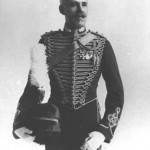Major-General HA Panet CB, CMG, DSO (1869 – 1951)
 Major-General Henri Alexandre Panet was born in Quebec City on 24 July 1869; he graduated from the Royal Military College in the summer of 1891 and qualified Lieutenant in the Royal Canadian Artillery on 2 May 1894.
Major-General Henri Alexandre Panet was born in Quebec City on 24 July 1869; he graduated from the Royal Military College in the summer of 1891 and qualified Lieutenant in the Royal Canadian Artillery on 2 May 1894.
In October 1899 Captain Panet was placed on establishment of the 2nd (Special Service) Battalion, Royal Canadian Regimen and dispatched as part of the 1st Contingent for service in South Africa; he was to join “C” Battery on its arrival. He was disappointed to learn that his battery would not arrive until March and feared that after Buller’s relief of Ladysmith and the surrender of General Cronje at Paardeberg Drift, there would be no opportunity to see action.
His fears proved groundless as “C” Battery, assigned to the Rhodesian Field Force, soon began an epic journey. Panet sailed with his battery from Cape Town to Beira, Portuguese East Africa. Here they debarked and began their march through Rhodesia and the Transvall to link with Colonel Plummer’s forces for the relief of Mafeking. This memorable march was described by Field-Marshall Lord Roberts as “one of incredible rapidity”.
Under Panet’s direction a fortified camp, named Fort Canada, was built at Rustenberg. Sections of “C” Battery supported small mounted columns operating from this safe haven and made a dozen sorties into the surrounding country. In recognition of his work in this campaign Panet was awarded the Distinguished Service Order.
On return to Canada and promotion to Major in May 1901, he was appointed Staff Adjutant at the Royal Military College. Following two senior staff appointments during the period 1905-1909 he was appointed to command “B” Battery. The battery prospered under his leadership, twice winning the coveted Royal Canadian Field Artillery Challenge Cup.
His promotion of Lieutenant-Colonel on 1 May 1911 was accompanied by his appointment to command the Royal Canadian Horse Artillery Brigade, and as Commandant of the Royal School of Artillery, Kingston, positions he held until late 1916. During his tenure, he took a personal interest of all aspects of training. His brigade was deeply involved in the training of the artillery units of the Active Militia. In 1912, twenty-six field batteries from eastern and central Canada assembled for training at Camp Petawawa. Lieutenant-Colonel Panet supervised the training; his involvement was summed up in the words of a First World War Gunner,
“I can only say that the Canadian Artillery could never have done the job it did without the wonderful pre-war training we had under the officers and gunnery instructors of the RCHA at Petawawa, with such men as Burstall, Panet, Elkins, Boak, Constantine and many others. To them Canada’s debt is very great.”
The eve of the First World War found Panet in Petawawa with his Brigade. After a quick return to Kingston, they were soon on the way to Valcartier to assist in the administration and training of the Canadian Expeditionary Force.
On 26 August the Brigade was mobilized and on 1 October departed for England to spend a miserable winter on the Salisbury Plain. Lieutenant-Colonel Panet deployed to Flanders with his Brigade on 25 July 1915. After being held in reserve they finally went into action on the Somme in late November. On 24 June 1916 he was promoted Colonel and Mentioned-in-Dispatches. He was to receive this distinction a total of seven times.
In December 1916 he was promoted Brigadier-General and appointed Commander, Royal Artillery 2nd Canadian Division, an appointment he held until April 1919. He was promoted again on 4 May 1921 and served as District Officer Commanding Number 1 District from October 1919 until June 1922 and in the same appointment in Number 2 District from June 1922 to June 1923. He was appointed Adjutant General on 1 July 1922 and retired to pension on 31 December 1930 having served The Royal Regiment for more than 40 years.
Major-General Panet continued to serve The Royal Regiment after his retirement as the Colonel Commandant.
He died in Kingston on 14 August 1951 and was buried with full military honours.


